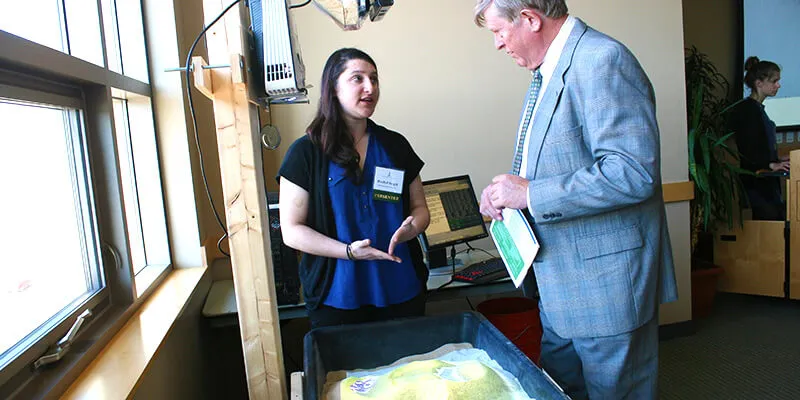What is an Augmented Reality Sandbox? Ask Rubenstein School senior Rachel Seigel and her eyes light up. She’s built one, and she intends to build her career around it.
An ARS produces a 3-D visualization of water flowing along landscape elevations using a box of sand and projected images of topographic contour lines and simulated water. Scientists and educators can use the machine to teach geologic, geographic, and hydrologic concepts – how watersheds, catchments, and levees work. By playing in the sandbox and scooping sand into hills and valleys, the image of flowing water projected onto the sand changes.
With 300 or so Augmented Reality Sandboxes in the world, Seigel is one of the first people to build a machine of her own. An environmental studies major, Seigel envisions using the machine to predict and demonstrate the impacts of climate change and flooding on developed areas.
“You can scope the ARS projection down to a backyard and up to the whole country,” she said. “I want this to be a tool for my focus on climate change.”
As an intern with Maine Audubon at their Scarborough Marsh Center last summer, Seigel led educational programs about the natural history of the surrounding salt marsh. At a water day festival, a demonstration of an ARS by staff from the U.S. Geological Survey fascinated her.
After witnessing the ARS exhibit, she suggested to Linda Woodward, her supervisor at the Center, that they construct an ARS to teach visitors about climate change, watersheds, flooding, and disaster prediction and prevention.
“It can make climate change real to local visitors,” Seigel proposed. “They can see what might happen during a flooding disaster and if their home will be underwater based on climate predictions.”
At her supervisor’s request, Seigel submitted a budget which Audubon initially turned down. She forged ahead, took on a second job, and sought family support to cover half the needed funding. Maine Audubon readily supplied the remainder of the funds, and she was off and running.
She did her research and learned all she could from a team at the University of California-Davis led by Dr. Oliver Kreylos, one of the original inventors of the ARS. Familiar with work on Augmented Reality Sandboxes around the world, the team collaborates with other ARS experts and users, including Burlington, Vermont’s ECHO Lake Aquarium and Science Center, which features an interactive ARS for its teen and adult visitors.
During her free time that summer, Seigel built her dream machine in her grandparents’ garage located five minutes from the Audubon Center in Scarborough. Her grandfather was among the first computer builders in the nation.
With his help and tools and her own ingenuity, Seigel gutted an old computer and retrofitted it with the parts she needed. She adapted a Microsoft Xbox 360 with Kinect and a 3-D projector to communicate with the computer. Out of two-by-fours and plywood, she constructed a stand to hold the sandbox and electronic equipment.
“I learned carpentry and computer programming all on my own over the summer,” she said.
She used an open source software program created by the UC-Davis researchers. From Kreylos and his lab, she learned that no one has yet tried her idea of adding toy houses and trees to the sandbox to simulate a living landscape. The computer program code would need to be modified. For now, she’s joined the AR Sandbox support forum run by the UC-Davis team, so she can stay up-to-date on the latest software coding.
Seigel, who graduates from UVM in May after finishing her undergraduate program within three years, sees her future as part of a team of researchers and programmers who can make those software modifications.
She completed construction of her ARS by the end of the summer and demonstrated the machine to Audubon educators and conservation staff at the Marsh Center.
“Rachel’s crowning achievement at the Marsh was creating an AR Sandbox,” said Linda Woodward, the Center’s director and educator. “She worked very hard to create this excellent resource for the Marsh.”
Since the introduction of the ARS into her life, Seigel, originally interested in environmental law and justice, has switched her career trajectory.
“I’d like to work with cities and towns in disaster prevention related to climate change, hurricanes, and flooding,” she said.
She’s begun to blaze her trail. This semester, she took a beginner programming class as she considers a Master’s degree program that leans toward engineering and computer science. And she turned her Automated Reality Sandbox into an environmental studies senior thesis capstone project which she demonstrated at the UVM Student Research Conference on April 28 in UVM’s Davis Student Center.
This summer, Seigel will collaborate with Dr. Donna Rizzo of the UVM College of Engineering and Mathematical Sciences (CEMS), her graduate students, and two local high school students to make improvements to the Automated Reality Sandbox. Seigel's passion and hard work have led to a graduate school opportunity in CEMS starting in the fall.
"When Rachel contacted me, her excitement was infectious and very indicative of why these systems are so popular with science museums and public outreach events," said Rizzo, who herself was mesmerized by her first experience playing in an AR Sandbox. "I've always wanted to find a way to use the ARS system to help explain some of the Vermont EPSCoR research on adaptation to climate change (RACC) we're doing in the Lake Champlain Basin. I'm hoping this summer that Rachel, in tandem with a few of my graduate students and some of the new EPSCoR undergraduate interns, might develop an educational module to help spread the fun and excitement of this research in a more hands-on way."
